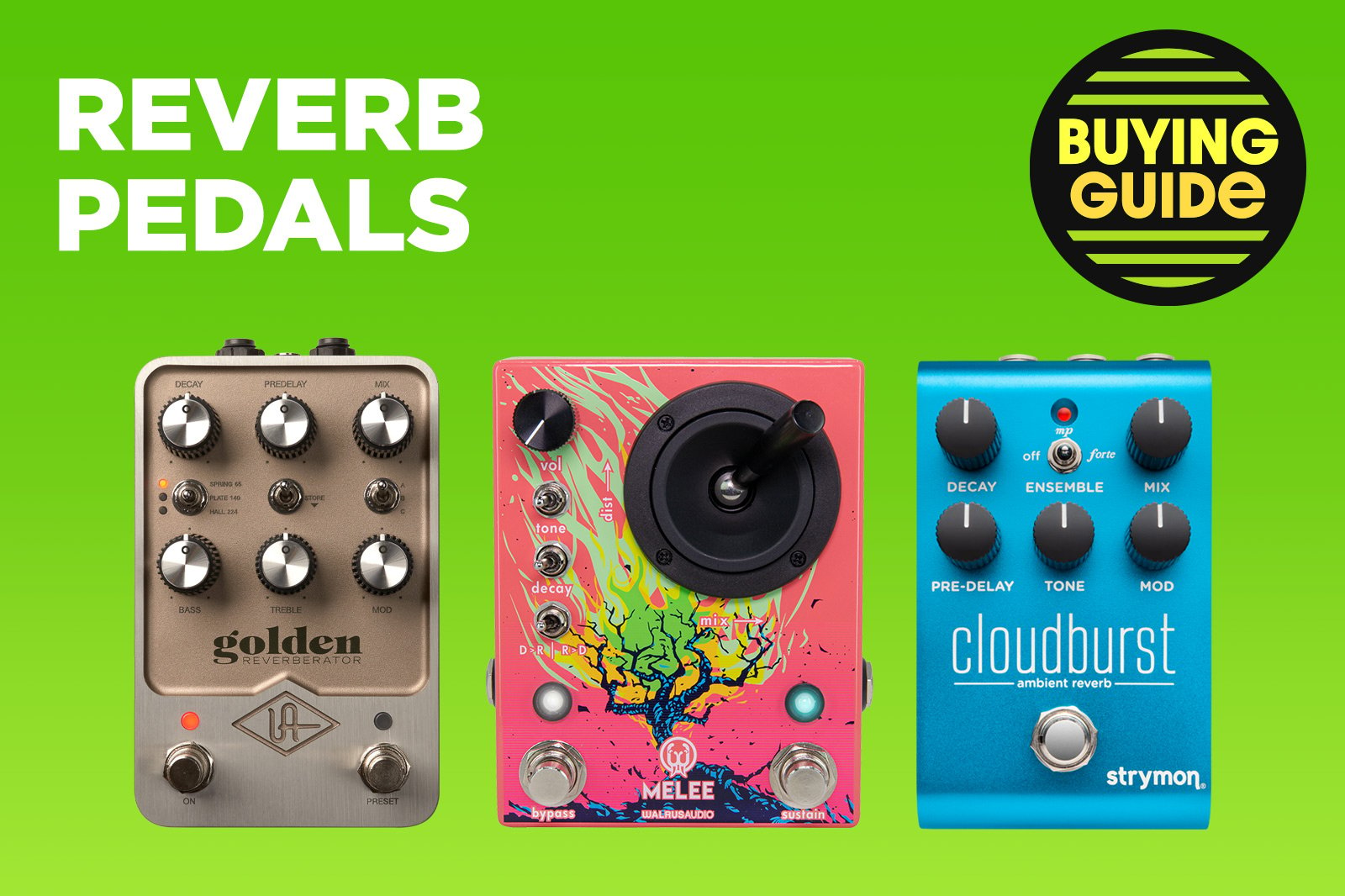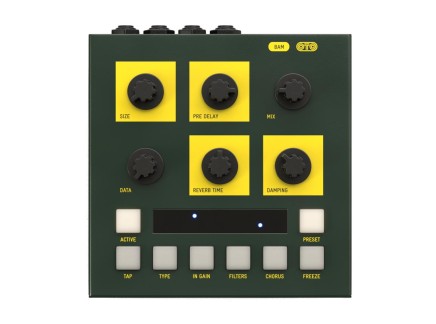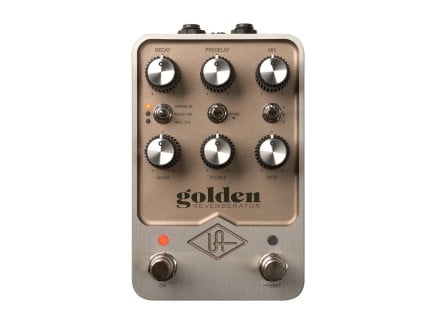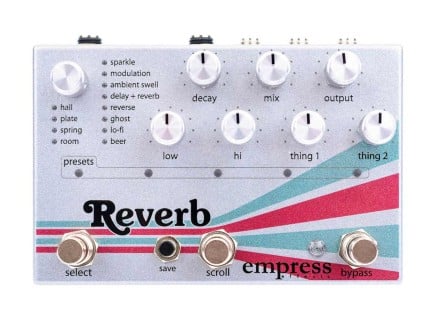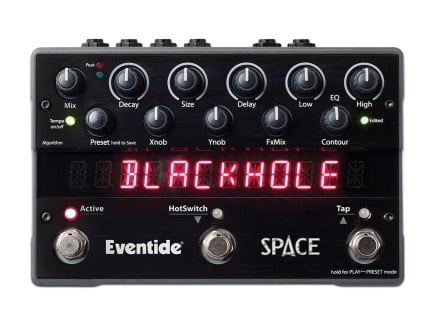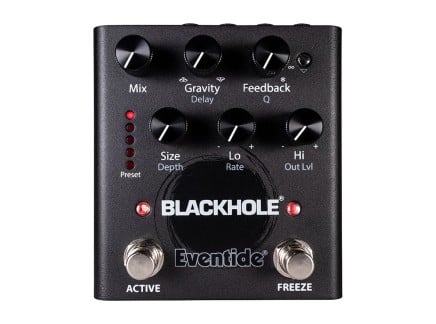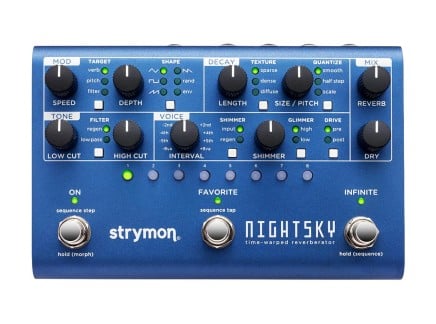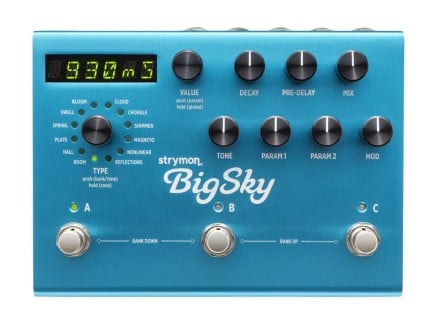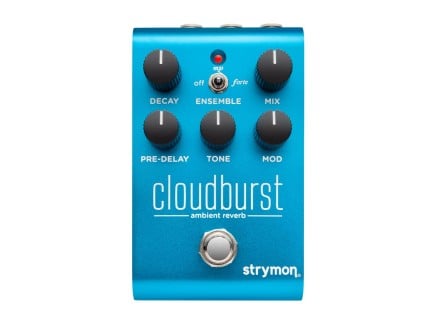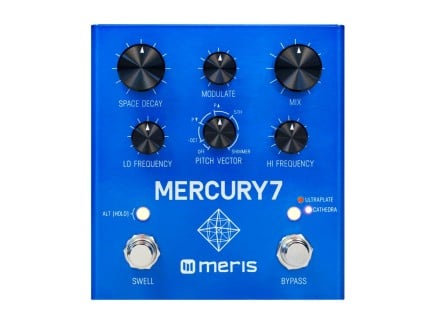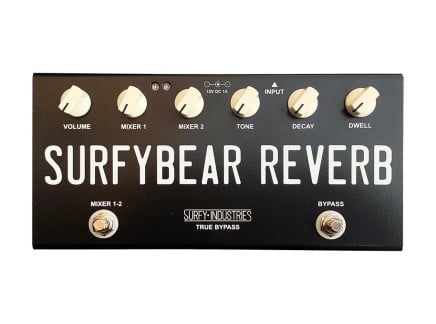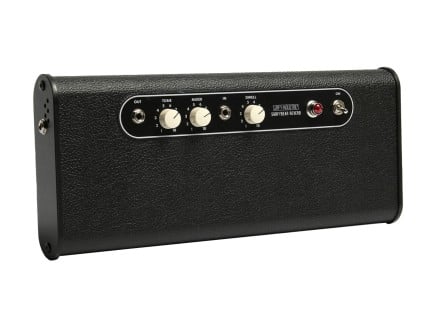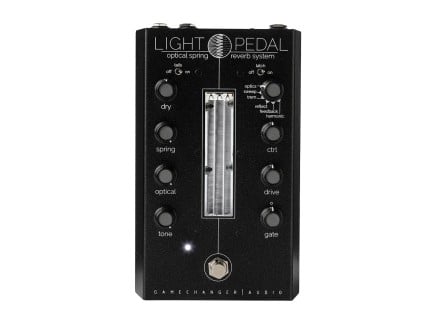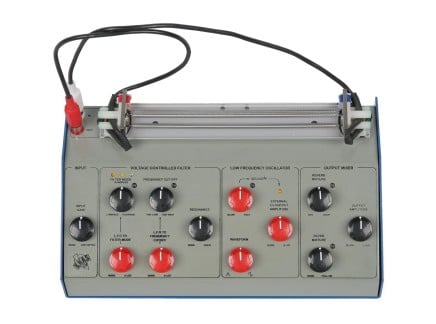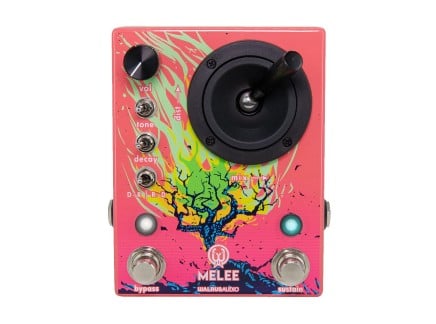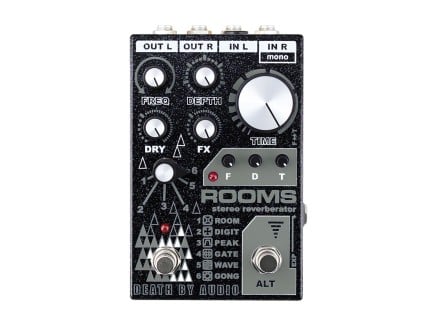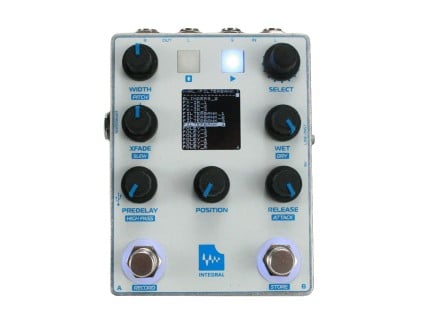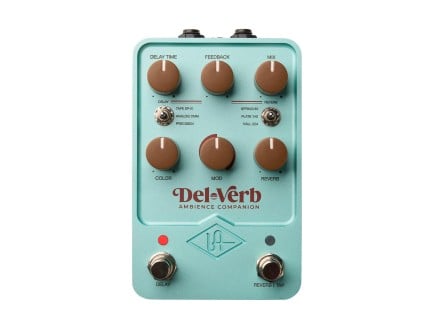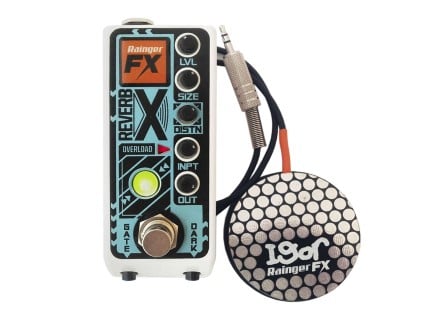Reverb was initially introduced as an effect in the 1930s. The effect was produced by playing back recordings through speakers or monitors into a large space and recording the sound of the room.
This makes the sonics coming out of the speakers more authentic and adds a sense of realism to the sound. However, the effect has evolved a lot over the years—from electroacoustic processes to compact effect processors, completely virtual plugins, and, of course...effect pedals. Regardless if you’re a guitar or synth player, engineer, producer, even a bassist—reverb has a place in your sound.
Here are some of the most unique and innovative reverb pedals on the market today. Let's take a look first at bread and butter digital reverbs, some more otherworldly and expansive digital reverbs, honest-to-goodness spring reverb pedals, and a couple of other particularly gnarly reverb pedals.
Bread and Butter Digital Reverb Pedals
OTO Machines BAM
Take one look at the BAM and you’ll realize right away this isn’t your run of the mill reverb pedal. OTO Machines packs a lot of proverbial punch into it, and it’s especially perfect if you’re looking for reverb sounds that set themselves apart from the ordinary.
Across the seven algorithms you get settings for standard plate, room, and hall. Things get more interesting with the chorus and ambient settings, and things totally go off the rails in the best way with the primitive and non-linear patches. The fact that you can add modulation is a feature not found in many reverb pedals, and there’s even a freeze switch to provide an infinite hold over your sound. It also runs at 15v, providing increased headroom.
The best thing about the BAM is its organic sound and versatility. The amount of reverb types, the wide range of the control set, the versatile high and low-pass filters, stereo I/O, MIDI input, and 36 user presets make this a well-rounded reverb machine. It’s pricey, but worth every bit of it.
Universal Audio Golden Reverberator
As one of the premier plugin manufacturers, Universal Audio has stepped into the effects pedal game in big ways. And they packed all of the vaunted reverb sounds that power their plugins into the Golden Reverberator.
It’s powered by dual processors that provide the accurate modeling of the hardware reverb units that inspired the design. There are three reverb sounds, and each of those has three models of algorithms to choose from. There’s a Fender amp-inspired spring, an EMT-140 plate, and a hall that takes after the classic Lexicon outboard gear of the 1970s.
USB-C connectivity offers an easy way to update the firmware as Universal Audio rolls them out. You can even add more sounds than what comes stock. There is a digital plate reverb with a vintage sound and a chamber, with more sounds set to be released in the future. By connecting to UA’s FX Control software you can further customize controls by setting the type of bypass and how the reverb tails reacts.
Two foot switches let you use it in “live” or “preset” mode, so it’s just as easy to use it in the moment as it is to recall your favorite sounds in the moment. If you’re looking to harness the power of UAD reverbs on your pedalboard this is a great simple, but powerful, stereo model that won’t take up too much real estate.
Empress Effects Reverb
The Empress Effects Reverb is a behemoth of sonic space, and one of the most robust reverb pedals on the market. It boasts 12 different types of reverbs across 32 studio-grade algorithms that go from the familiar to esoteric settings like Sparkle, Ghost, and the infinitely interestingly titled Beer.
It can store five presets that are selectable through the center footswitch. Most of the sounds either offer an infinite hold setting or tap tempo for tailoring the timing to exactly what the song needs. If the sheer amount of reverb sounds it offers isn’t enough, it’s the cabinet simulation and output transformer that truly sets it apart from the pack.
Connectivity won’t be an issue, so no matter how you like to route the signal of your rig the stereo I/O accommodates. You can use an external expression pedal to control things in real-time, or an external tap tempo to get the perfect interval of repeats.
The enclosure is on the larger side, essentially taking up two spaces on your board. But with all of these reverb sounds, thankfully you can store up to 35 of them. So recalling them won’t be an issue. If you need a reverb pedal that can provide the spring spank of a tube amp all the way up to the craziest experimental shoegaze sounds you could want, this is a great option with a powerful DSP engine and loads of flexibility.
Expansive Digital Reverb Pedals
Eventide Space
When it comes to digital effects, Eventide makes some of the most useful and easiest to use. Space offers a great variety of different reverb sounds, so no matter what reverb sound you’re chasing you get that and more.
With this many sounds, an effect has to offer a good amount of preset storage and control, which is where the Space really shines. It can be used in mono or stereo, and it’s built to withstand the rigors of the road.
The Space is tailor-made for the guitarist that needs a versatile reverb that can withstand the abuse of travel. No matter what sounds you’re looking for, it’s in here. The price tag is a little hefty, but with it you get everything you need in a fairly compact and easy-to-find package.
Eventide H90
The H90 isn’t a tried-and-true reverb, but a pedalboard version of Eventide’s groundbreaking Harmonizer series rack units. It doesn’t include all of the patches from the full H9000, but does give you 62 effects to work with—with the ability to use two effect algorithms at one time. This, of course, includes a wide assortment of classic Eventide reverb algorithms, from the venerable SP2016 to the Blackhole algorithm and many, many more.
It’s easy to dial in on the pedal, and you can further customize your sounds through the H90 control software. There are complex ways you can route it, from mono to stereo, in series or parallel, and it can be controlled through MIDI switching and an external expression pedal.
While it’s not a dedicated reverb pedal, it provides plenty of different types of spaces on top of all the other effects. This makes it a perfect Swiss army knife type of pedal. It’s not cheap, and the sound sets can be daunting at first. But there’s a reason why this effect and its predecessors have maintained their reputation for decades.
Eventide Blackhole
Eventide’s third entry here is much more streamlined, and provides great standard reverb sounds ideally suited for whatever type of signal you throw at it. Derived from the classic algorithm from the DSP4000 and countless other devices since, Blackhole packages one of Eventide's most popular effects into an affordable, compact package.
You can use up to 127 presets through MIDI, and they can be arranged through Eventide’s Device Manager software. The footswitch toggles between latching and momentary modes, and a dedicated freeze switch lets you hold out sounds as you like. All parameters can be mapped to an external expression pedal for real-time control.
It’s one of the simpler reverb pedals on the list, but sports all of Eventide’s peerless digital sounds into an enclosure that’s a friendly size for your pedalboard. It’s mono only on the input and stereo on the output, but you need to select the mode of operation through a switch on the back. Even better, another switch sets it for operation of guitar or line level sources, making it great for the studio too.
Strymon Nightsky
Strymon makes some of the best digital pedals of the current era, so there’s a lot to unpack in their reverbs. The Nightsky comes equipped with an intense control set that feels overwhelming at first, but really they just give you different options of dialing in standard reverb controls.
"Experimental" doesn’t do this pedal justice, as it’s just as useful at running plate sounds as it is for the trippiest of shoegaze riffs. It’s fully stereo, comes with ways to add shimmer and glimmer to your sound, has switchable bypass modes, and can take Hi-Z or line level signals.
This isn’t a reverb for the faint of heart. It will take a while to dial in, and you’ll find yourself constantly pushing the boundaries of what it can do. But if you’re looking for a reverb pedal that runs the sound gamut and works with any type of signal the price tag is worth it.
Strymon Bigsky
The Bigsky is Strymon’s more "base" reverb pedal, and you can tell at first looking at it. A rotary knob selects between 12 sound presets, and eight pots dial in the sounds from there.
You get 300 presets for storing your sounds, and infinite sustain/freeze modes can be set for each. One of the coolest features is the speaker cabinet emulation, so you don’t have to be shy about running it direct as the last pedal in your signal chain.
The Bigsky is best for players who need a good base reverb sound with the ability to get freaky if you need to. It’s easy to dial in, save your presets, and start playing. But it’s the additional flavors it adds that make it a professional pedalboard staple. That said, if you find you like the character of Bigsky but don't need all the bells and whistles, we can recommend the Bluesky, which offers similar sounds with a pared-back set of controls.
Strymon Cloudburst
The Cloudburst is the most pedalboard-friendly of Strymon’s reverbs and is based on the Cloud algorithm from the Bigsky. The Ensemble engine adds further harmonic layers to give you a great base for the reverb sounds that sit on top.
It’s easy to dial in and slides in anywhere on your board. It’s mono only on the input, but can split out to stereo on the output. There’s an expression/MIDI jack that provides further real-time control.
The Cloudburst is a simple pedal, perfect for players who want something uncomplicated. That’s not to say it can’t conjure up more progressive sounds. But it’s a great small-format reverb with a great amount of settings and controls.
Meris Mercury 7
Some reverbs provide a basic sound, and some are intended to give the most ethereal, space-age sounds possible. The Mercury 7 is that latter. It’s a modern take on some of the trippiest reverb sounds of the 1980s from sci-fi thrillers like Blade Runner.
Through 24-bit conversion you can get great base reverb sounds, but there’s enough in here to get weird with it if you want. The control scheme isn’t hard to interpret, with decay, high and low EQ controls, modulation, and a wet/dry mix knob. The swell witch extends any sound infinitely, and you can even use it with external MIDI controllers, or trigger it through automation in your DAW.
A unique Pitch Vector control that lets you dial in additional octaves to achieve a variety of effects, including shimmer. Through it you can set the octave below as well as detuning. Or you can go up a 5th or a single octave. The Mercury 7 is a great all-around reverb that can access unique sounds, but it’s great for more standard uses as well.
Spring Reverb Pedals
Surfy Industries SurfyBear
Many players want a spring reverb pedal that provides real amp sounds. And they’re in luck with the SurfyBear from Surfy Industries. It’s based on the spring reverb circuit from the Fender 6G15, one of Fender’s premier, dedicated reverb units. To fit everything into a guitar pedal, Surfy Industries replaced the tube elements with MOSFET and JFET transistor solid-state components, but don’t think that means the tone takes a step backward.
It couldn’t be simpler to dial in. You set your sounds through Dwell, Decay, and Tone controls. A global volume knob adds additional gain at the end of the chain to compensate for any volume loss. There are two Mixer controls for setting the wet/dry blend for either of the two available presets. Running at 12V, you don’t have to worry so much about the signal clipping.
Even though it’s based on one of the best hardware reverb tanks of all time, some players might find its lack of sound options a turnoff. But spring reverb is perfect for guitar. So if you’re looking to introduce vintage tube reverb tone into your signal chain but need it in a pedalboard format this is a terrific option that’s simple while still staying authentic.
Gamechanger Light Pedal
Gamechanger Audio makes some of the most identifiable modern gear, and the LIGHT Pedal is no different. But it’s not just how visually appealing it is. This unique spring reverb uses optical sensors to morph the specific characteristics of the six reverb sounds inside. This helps to retain some of the energy that’s lost in the traditional spring mechanism of this type of reverb.
New sonic worlds open that previously just weren’t available with a standard spring reverb. By using an optical topology you get access to sounds found in more advanced reverbs like shimmer and modulation, even tremolo!
It offers a sophisticated control set for a spring reverb, with ways to tailor unique parameters like driving the spring tank and optical sensors, and the amount of the guitar’s dry signal as it flows into the pedal. Harmonics of the sound can be set through the Tone control. But it’s the Envelope control that does the heavy lifting. This lets you shape the dynamics that can go from a full-on reverb assault to choppy, gated sounds.
The Control knob sets a unique three-level shock sensor parameter based on the selected reverb sound. Dynamics of the reverbs are set through the Envelope knob. Reverb tails can be on or off, so you don’t have to worry about where you place the pedal in your signal chain. It can be used in momentary or latching modes.
It’s not without its downsides though. It runs in mono only, and even though the sounds are more robust than the standard spring reverb, the presets are a little limited to a particular category of reverb. But the different ways you can use it, even kicking it like a traditional reverb tank, makes it a great option for guitars and vocals.
Knas Ekdahl Moisturizer
The Moisturizer is one of the more esoteric reverbs around today, but don’t let that scare you off. Under the hood it’s a combo reverb and preamp that can access some pretty insane sounds. The initial way it sets itself apart from the pack is through the exposed strings that let you control the effect manually.
Thanks to the onboard preamp it works with instruments of all input levels. But the Moisturizer goes way deeper than that. Most of the parameters are controllable through the CV and expression pedal input. But it’s in the advanced EQ section where things really get interesting. The bandpass filter sweeps through low and high pass, with the ability to narrow down the frequencies even more. Both the reverb and filtering can be dialed in to achieve the perfect wet/dry balance.
It might not be an “always on” type of reverb for the sound you’re going for, but creatively it offers a very cool spin on a tried-and-true sound. It’s a unique design, so it might not be the ideal pedal to use on your board. But if you want a reverb that’s an out-of-the-box idea it makes a great, forward-thinking pedal for use in the recording studio.
Gnarly Reverb Pedals
Walrus Audio Melee
After the Moisturizer, how could things get any weirder? The Melee is a combined reverb and distortion that you dial in by using a…joystick! It’s powered by three programs - Ambient, Reverse, and Octave Down.
Moving it vertically dials in the gain of the distortion part of the circuit, and moving it horizontally adjusts the overall wet/dry mix of the reverb. Both effects can be arranged for what best fits your signal chain. Beyond the joystick, it forsakes the traditional control set for just a few switches to tailor your sound even more. The Sustain footswitch introduces infinite sustain as long as it’s held down.
Make no mistake, this is a reverb for the experimental. Sure, it can be used as a part of your main sound, but where it accels is getting weird. It only runs in mono, and there’s not a great level of control over the sounds, so you just have to do the best with what it offers. And that’s a unique take on a reverb/distortion circuit that provides a fun way to dial it in.
Death by Audio Rooms
Death by Audio always seems to strike the perfect balance between the breadth of features in their pedals and making them in a convenient, ergonomic footprint. Rooms, their stereo reverb, features multiple algorithms that provide a wide range of sounds.
A global time knob controls that parameter regardless of the setting. The Frequency and Depth controls are setting-dependent, and they govern things like the depth of modulation, filtering, and further customizing the reverb delay time. Expression pedal input and alternate controls give you an added layer of control options
It’s much more than stereo, and can be used in mono, dual mono, and mono to stereo applications. So no matter how the signal flow of your rig is designed it slides in seamlessly. There’s no plate or spring settings, but this is a great choice for guitarists looking for the standard but aren’t afraid to step into the unordinary.
Conclusions?
Reverb pedals are a great way to expand your sound. From the familiar to the bizarrest of the unknown, they open up your sound in a way that no other type of guitar effect can. And there’s never been a better time to find the perfect reverb for your style.

